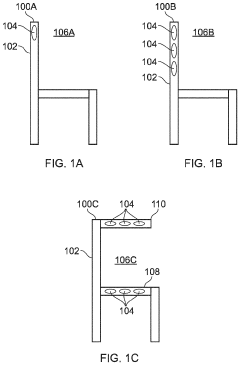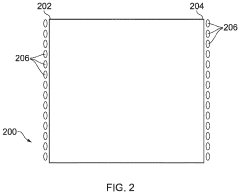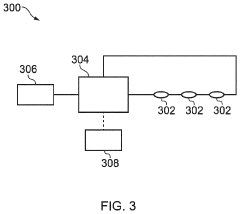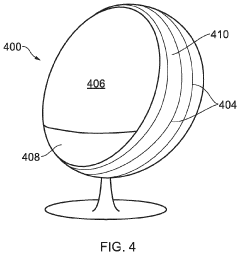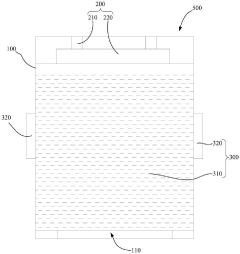How to Use Schumann Resonance for Advanced Environmental Solutions?
JUN 24, 202510 MIN READ
Generate Your Research Report Instantly with AI Agent
Patsnap Eureka helps you evaluate technical feasibility & market potential.
Schumann Resonance Background and Objectives
Schumann resonance, discovered by physicist Winfried Otto Schumann in 1952, refers to the natural electromagnetic frequencies occurring in the Earth's ionosphere. These resonances, primarily at 7.83 Hz and its harmonics, have been a subject of scientific interest for decades. The study of Schumann resonance has evolved from a purely theoretical concept to a practical tool with potential applications in various environmental and technological domains.
The historical development of Schumann resonance research has seen significant milestones. Initial observations were limited to theoretical predictions, but advancements in measurement techniques have allowed for precise detection and analysis of these resonances. Over time, researchers have identified correlations between Schumann resonance patterns and various natural phenomena, including global lightning activity, ionospheric disturbances, and even potential links to biological systems.
In recent years, there has been a growing interest in leveraging Schumann resonance for advanced environmental solutions. This interest stems from the realization that these resonances could serve as a global indicator of various environmental changes and processes. The primary objective in this field is to develop innovative methods and technologies that can harness Schumann resonance data for practical environmental applications.
One of the key goals is to utilize Schumann resonance measurements for improved climate monitoring and prediction. By analyzing variations in resonance patterns, researchers aim to gain insights into global temperature changes, atmospheric composition alterations, and other climate-related phenomena. This could potentially enhance our understanding of climate change dynamics and contribute to more accurate climate models.
Another significant objective is the application of Schumann resonance in natural disaster prediction and early warning systems. Studies have suggested correlations between anomalies in Schumann resonance patterns and the occurrence of earthquakes, tsunamis, and severe weather events. Developing reliable detection and analysis methods could lead to more effective early warning systems, potentially saving lives and reducing economic impacts of natural disasters.
Furthermore, there is growing interest in exploring the potential of Schumann resonance in health and wellness applications. Some researchers hypothesize that these natural frequencies may have biological effects on human health and cognitive function. The objective here is to investigate these potential effects and, if proven beneficial, develop technologies that could simulate or enhance exposure to these natural frequencies in urban environments where they might be masked by electromagnetic pollution.
As technology advances, the aim is to develop more sensitive and accurate measurement devices capable of detecting subtle changes in Schumann resonance patterns. This includes the creation of a global network of monitoring stations to provide comprehensive, real-time data on these resonances. Such a network could serve as a powerful tool for various environmental monitoring and research applications.
The historical development of Schumann resonance research has seen significant milestones. Initial observations were limited to theoretical predictions, but advancements in measurement techniques have allowed for precise detection and analysis of these resonances. Over time, researchers have identified correlations between Schumann resonance patterns and various natural phenomena, including global lightning activity, ionospheric disturbances, and even potential links to biological systems.
In recent years, there has been a growing interest in leveraging Schumann resonance for advanced environmental solutions. This interest stems from the realization that these resonances could serve as a global indicator of various environmental changes and processes. The primary objective in this field is to develop innovative methods and technologies that can harness Schumann resonance data for practical environmental applications.
One of the key goals is to utilize Schumann resonance measurements for improved climate monitoring and prediction. By analyzing variations in resonance patterns, researchers aim to gain insights into global temperature changes, atmospheric composition alterations, and other climate-related phenomena. This could potentially enhance our understanding of climate change dynamics and contribute to more accurate climate models.
Another significant objective is the application of Schumann resonance in natural disaster prediction and early warning systems. Studies have suggested correlations between anomalies in Schumann resonance patterns and the occurrence of earthquakes, tsunamis, and severe weather events. Developing reliable detection and analysis methods could lead to more effective early warning systems, potentially saving lives and reducing economic impacts of natural disasters.
Furthermore, there is growing interest in exploring the potential of Schumann resonance in health and wellness applications. Some researchers hypothesize that these natural frequencies may have biological effects on human health and cognitive function. The objective here is to investigate these potential effects and, if proven beneficial, develop technologies that could simulate or enhance exposure to these natural frequencies in urban environments where they might be masked by electromagnetic pollution.
As technology advances, the aim is to develop more sensitive and accurate measurement devices capable of detecting subtle changes in Schumann resonance patterns. This includes the creation of a global network of monitoring stations to provide comprehensive, real-time data on these resonances. Such a network could serve as a powerful tool for various environmental monitoring and research applications.
Market Analysis for Schumann Resonance Applications
The market for Schumann Resonance applications in advanced environmental solutions is experiencing significant growth and diversification. As awareness of the potential benefits of harnessing these natural electromagnetic frequencies increases, various industries are exploring innovative ways to integrate this technology into their products and services.
In the healthcare sector, there is a growing demand for Schumann Resonance-based therapies and wellness devices. These applications range from stress reduction and sleep improvement to potential treatments for certain medical conditions. The global wellness market, valued at over $4 trillion, presents a substantial opportunity for Schumann Resonance technologies to capture a share in the coming years.
Environmental monitoring and prediction systems represent another promising market segment. With climate change concerns escalating, there is an increased need for accurate and comprehensive environmental data. Schumann Resonance measurements can provide valuable insights into global weather patterns, ionospheric conditions, and potentially even seismic activity prediction. This market is expected to grow as governments and organizations invest more in climate research and early warning systems.
The agriculture industry is also showing interest in Schumann Resonance applications. Some studies suggest that these frequencies may influence plant growth and crop yields. As sustainable farming practices gain traction, technologies that can optimize crop production without harmful chemicals are in high demand. This presents an opportunity for Schumann Resonance-based solutions in precision agriculture and crop management systems.
In the realm of telecommunications and navigation, Schumann Resonance applications are being explored for their potential to enhance signal propagation and improve the accuracy of global positioning systems. As the demand for more reliable and precise navigation technologies grows, especially with the advent of autonomous vehicles and drones, this market segment could see significant expansion.
The energy sector is another area where Schumann Resonance applications are gaining attention. Some researchers are investigating the possibility of harnessing these resonances for wireless power transmission or as a potential renewable energy source. While still in early stages, this could represent a disruptive technology in the energy market if successfully developed.
Consumer electronics manufacturers are also beginning to incorporate Schumann Resonance technology into their products. From wearable devices that claim to improve well-being to home appliances designed to create a more natural electromagnetic environment, this consumer market segment is showing promising growth potential.
As research continues and new applications emerge, the market for Schumann Resonance technologies in environmental solutions is expected to expand further. However, challenges such as public awareness, scientific validation, and regulatory approval will need to be addressed to fully realize the market potential of these innovative applications.
In the healthcare sector, there is a growing demand for Schumann Resonance-based therapies and wellness devices. These applications range from stress reduction and sleep improvement to potential treatments for certain medical conditions. The global wellness market, valued at over $4 trillion, presents a substantial opportunity for Schumann Resonance technologies to capture a share in the coming years.
Environmental monitoring and prediction systems represent another promising market segment. With climate change concerns escalating, there is an increased need for accurate and comprehensive environmental data. Schumann Resonance measurements can provide valuable insights into global weather patterns, ionospheric conditions, and potentially even seismic activity prediction. This market is expected to grow as governments and organizations invest more in climate research and early warning systems.
The agriculture industry is also showing interest in Schumann Resonance applications. Some studies suggest that these frequencies may influence plant growth and crop yields. As sustainable farming practices gain traction, technologies that can optimize crop production without harmful chemicals are in high demand. This presents an opportunity for Schumann Resonance-based solutions in precision agriculture and crop management systems.
In the realm of telecommunications and navigation, Schumann Resonance applications are being explored for their potential to enhance signal propagation and improve the accuracy of global positioning systems. As the demand for more reliable and precise navigation technologies grows, especially with the advent of autonomous vehicles and drones, this market segment could see significant expansion.
The energy sector is another area where Schumann Resonance applications are gaining attention. Some researchers are investigating the possibility of harnessing these resonances for wireless power transmission or as a potential renewable energy source. While still in early stages, this could represent a disruptive technology in the energy market if successfully developed.
Consumer electronics manufacturers are also beginning to incorporate Schumann Resonance technology into their products. From wearable devices that claim to improve well-being to home appliances designed to create a more natural electromagnetic environment, this consumer market segment is showing promising growth potential.
As research continues and new applications emerge, the market for Schumann Resonance technologies in environmental solutions is expected to expand further. However, challenges such as public awareness, scientific validation, and regulatory approval will need to be addressed to fully realize the market potential of these innovative applications.
Current State and Challenges in Harnessing Schumann Resonance
The current state of harnessing Schumann Resonance for advanced environmental solutions is characterized by both promising developments and significant challenges. Researchers have made substantial progress in understanding the potential applications of Schumann Resonance in environmental monitoring and forecasting. However, the practical implementation of these applications faces several obstacles.
One of the primary challenges is the difficulty in accurately measuring and isolating Schumann Resonance signals from background noise. The extremely low frequency of these resonances (around 7.83 Hz for the fundamental mode) makes them susceptible to interference from various natural and artificial sources. This necessitates the development of highly sensitive and specialized equipment capable of detecting and analyzing these subtle electromagnetic signals.
Another significant hurdle is the limited understanding of the complex interactions between Schumann Resonance and various environmental phenomena. While correlations have been observed between Schumann Resonance variations and certain weather patterns or seismic activities, establishing clear causal relationships remains challenging. This gap in knowledge hinders the development of reliable predictive models based on Schumann Resonance data.
The interdisciplinary nature of Schumann Resonance research also presents challenges in terms of collaboration and knowledge integration. Effective utilization of this phenomenon for environmental solutions requires expertise from diverse fields such as atmospheric physics, geophysics, electrical engineering, and data science. Bridging these disciplines and fostering meaningful collaboration is crucial for advancing the field.
Furthermore, the global nature of Schumann Resonance necessitates international cooperation in data collection and analysis. Establishing a comprehensive network of monitoring stations around the world is essential for obtaining a complete picture of Schumann Resonance variations and their potential environmental implications. However, coordinating such efforts across different countries and institutions poses logistical and political challenges.
Despite these obstacles, recent advancements in sensor technology and data processing techniques have opened up new possibilities for harnessing Schumann Resonance. Improved magnetometers and sophisticated signal processing algorithms are enhancing our ability to detect and analyze Schumann Resonance signals with greater precision. Additionally, the integration of machine learning and artificial intelligence approaches is showing promise in identifying patterns and correlations that may have previously gone unnoticed.
As research in this field progresses, there is growing interest in exploring the potential of Schumann Resonance for early warning systems for natural disasters, climate change monitoring, and even applications in human health. However, translating these potential applications into practical, reliable environmental solutions remains a significant challenge that requires continued research, technological innovation, and interdisciplinary collaboration.
One of the primary challenges is the difficulty in accurately measuring and isolating Schumann Resonance signals from background noise. The extremely low frequency of these resonances (around 7.83 Hz for the fundamental mode) makes them susceptible to interference from various natural and artificial sources. This necessitates the development of highly sensitive and specialized equipment capable of detecting and analyzing these subtle electromagnetic signals.
Another significant hurdle is the limited understanding of the complex interactions between Schumann Resonance and various environmental phenomena. While correlations have been observed between Schumann Resonance variations and certain weather patterns or seismic activities, establishing clear causal relationships remains challenging. This gap in knowledge hinders the development of reliable predictive models based on Schumann Resonance data.
The interdisciplinary nature of Schumann Resonance research also presents challenges in terms of collaboration and knowledge integration. Effective utilization of this phenomenon for environmental solutions requires expertise from diverse fields such as atmospheric physics, geophysics, electrical engineering, and data science. Bridging these disciplines and fostering meaningful collaboration is crucial for advancing the field.
Furthermore, the global nature of Schumann Resonance necessitates international cooperation in data collection and analysis. Establishing a comprehensive network of monitoring stations around the world is essential for obtaining a complete picture of Schumann Resonance variations and their potential environmental implications. However, coordinating such efforts across different countries and institutions poses logistical and political challenges.
Despite these obstacles, recent advancements in sensor technology and data processing techniques have opened up new possibilities for harnessing Schumann Resonance. Improved magnetometers and sophisticated signal processing algorithms are enhancing our ability to detect and analyze Schumann Resonance signals with greater precision. Additionally, the integration of machine learning and artificial intelligence approaches is showing promise in identifying patterns and correlations that may have previously gone unnoticed.
As research in this field progresses, there is growing interest in exploring the potential of Schumann Resonance for early warning systems for natural disasters, climate change monitoring, and even applications in human health. However, translating these potential applications into practical, reliable environmental solutions remains a significant challenge that requires continued research, technological innovation, and interdisciplinary collaboration.
Existing Solutions Utilizing Schumann Resonance
01 Schumann resonance devices for health and wellness
Various devices have been developed to generate or utilize Schumann resonance frequencies for potential health benefits. These devices aim to simulate the natural electromagnetic frequencies of the Earth to promote relaxation, improve sleep quality, and enhance overall well-being. Some designs incorporate Schumann resonance generators into everyday objects or wearable devices for convenient use.- Schumann resonance devices for health and wellness: Various devices are designed to generate or utilize Schumann resonance frequencies for potential health benefits. These devices aim to simulate the natural electromagnetic frequencies of the Earth to promote relaxation, improve sleep quality, and enhance overall well-being. Some implementations include wearable devices, room-based generators, and portable units that emit Schumann resonance frequencies.
- Schumann resonance in electromagnetic shielding: Schumann resonance principles are applied in the development of electromagnetic shielding materials and structures. These innovations aim to protect electronic devices and living spaces from harmful electromagnetic radiation while maintaining the beneficial effects of natural Earth frequencies. Some designs incorporate Schumann resonance-friendly materials or structures in building components, clothing, or protective enclosures.
- Schumann resonance in energy harvesting and power generation: Researchers are exploring ways to harness Schumann resonance frequencies for energy harvesting and power generation. These technologies aim to capture and convert the Earth's natural electromagnetic energy into usable electricity. Potential applications include powering small electronic devices, sensors, or contributing to renewable energy systems.
- Schumann resonance in communication and signal processing: Schumann resonance frequencies are being investigated for potential applications in communication systems and signal processing. These innovations explore using Earth's natural frequencies as a carrier or reference for long-distance communication, navigation, or timing systems. Some concepts involve integrating Schumann resonance detection or generation capabilities into communication devices or networks.
- Schumann resonance measurement and monitoring systems: Advanced systems and methods are being developed for accurately measuring and monitoring Schumann resonance frequencies. These technologies aim to improve our understanding of Earth's electromagnetic environment, track changes in global weather patterns, and provide data for various scientific and practical applications. Some implementations include networks of sensors, data processing algorithms, and visualization tools for Schumann resonance analysis.
02 Schumann resonance in environmental monitoring and research
Schumann resonance is utilized in environmental monitoring and research applications. Devices and systems have been developed to measure and analyze these resonances for studying global electromagnetic phenomena, climate change, and atmospheric conditions. These technologies can provide valuable data for scientific research and environmental assessments.Expand Specific Solutions03 Integration of Schumann resonance in meditation and relaxation products
Schumann resonance frequencies are incorporated into various meditation and relaxation products. These may include specialized audio devices, meditation cushions, or relaxation chambers that generate or amplify Schumann resonance frequencies. The aim is to create an environment that promotes deeper relaxation and potentially enhances meditation practices.Expand Specific Solutions04 Schumann resonance in electromagnetic shielding and protection
Technologies have been developed to incorporate Schumann resonance principles in electromagnetic shielding and protection devices. These innovations aim to protect individuals from harmful electromagnetic radiation while maintaining exposure to beneficial Schumann resonance frequencies. Applications may include protective clothing, building materials, or personal devices.Expand Specific Solutions05 Schumann resonance applications in agriculture and plant growth
Research and development efforts have explored the potential benefits of Schumann resonance in agriculture and plant growth. Devices and systems have been designed to expose plants to these frequencies, potentially enhancing growth, improving crop yields, or increasing resistance to pests and diseases. These applications aim to leverage the natural electromagnetic environment for agricultural improvements.Expand Specific Solutions
Key Players in Schumann Resonance Research and Application
The field of Schumann Resonance for advanced environmental solutions is in its early developmental stage, with growing interest from both academic institutions and private companies. The market size is expanding as awareness of its potential applications increases. Technologically, it is still evolving, with varying levels of maturity across different applications. Universities like Jilin University, Wuhan University of Technology, and Harbin Institute of Technology are leading academic research, while companies such as VanJee Technology Co., Ltd. and Guangzhou Chumeixuan Biotechnology Co., Ltd. are exploring commercial applications. The technology's interdisciplinary nature, involving atmospheric physics, environmental science, and bioengineering, is attracting diverse players, including international entities like the University of Bern and GLOBALFOUNDRIES, Inc., indicating a global interest in its development and potential for environmental solutions.
Institute of Atmospheric Physics
Technical Solution: The Institute of Atmospheric Physics has developed a comprehensive approach to utilizing Schumann Resonance for advanced environmental solutions. Their method involves deploying a network of highly sensitive magnetometers to detect and analyze Schumann Resonance signals. These signals are then processed using advanced algorithms to extract information about global lightning activity, atmospheric electricity, and potential correlations with climate patterns. The institute has also developed models to use Schumann Resonance data for monitoring and predicting extreme weather events, as well as studying long-term climate trends.
Strengths: Extensive experience in atmospheric research, access to advanced equipment, and established data processing techniques. Weaknesses: Limited commercial applications and potential difficulties in scaling the technology for widespread use.
Fudan University
Technical Solution: Fudan University's approach to using Schumann Resonance for environmental solutions focuses on integrating this phenomenon with other environmental monitoring systems. Their research team has developed a multi-layered sensing platform that combines Schumann Resonance detection with air quality sensors, temperature and humidity monitors, and satellite data. This integrated system aims to provide a more comprehensive picture of environmental conditions and their potential impacts on human health. The university has also been exploring the use of Schumann Resonance patterns to detect and predict seismic activity, potentially enhancing early warning systems for earthquakes.
Strengths: Interdisciplinary approach combining multiple environmental factors, potential for wide-ranging applications. Weaknesses: Complexity of the integrated system may pose challenges for widespread implementation and maintenance.
Core Innovations in Schumann Resonance Detection and Utilization
A magnetic field exposure system and uses thereof
PatentPendingUS20230372726A1
Innovation
- A magnetic field exposure system generating an amplitude-modulated low frequency magnetic field with a carrier frequency of 360 to 450 Hz and a modulation frequency of 0.5 to 100 Hz, providing a field strength of 0.5 to 250 μT, specifically designed to enhance cell survival, proliferation, reduce stress, and promote tissue regeneration.
Water treatment apparatus and activated water treatment system
PatentActiveCN111762842A
Innovation
- A water treatment device is designed, including a shell and a sound wave generating component. The Schumann wave is generated through the piezoelectric ceramic vibrating plate and transmitted to the water body through the sound wave output port. It is combined with the sound wave amplification component to amplify the vibration energy and directly uses sound waves to conduct The activation of water molecules avoids costly molecular resonance film technology and photoelectric resonance.
Environmental Impact Assessment of Schumann Resonance Technologies
The environmental impact assessment of Schumann Resonance technologies is a critical component in evaluating the potential use of these natural electromagnetic frequencies for advanced environmental solutions. Schumann Resonances, discovered by physicist Winfried Otto Schumann in 1952, are global electromagnetic resonances generated and excited by lightning discharges in the cavity formed by the Earth's surface and the ionosphere.
The implementation of Schumann Resonance-based technologies for environmental purposes necessitates a comprehensive analysis of their potential effects on ecosystems, atmospheric conditions, and human health. One primary consideration is the interaction between artificially generated or amplified Schumann Resonances and natural electromagnetic fields. This interaction could potentially influence weather patterns, animal migration behaviors, and plant growth cycles, which are known to be sensitive to electromagnetic fluctuations.
Furthermore, the assessment must account for the potential impacts on the ionosphere and magnetosphere. Any large-scale manipulation of Schumann Resonances could theoretically alter the delicate balance of these upper atmospheric layers, potentially affecting global climate systems and communication technologies that rely on ionospheric reflection.
The evaluation should also consider the effects on biodiversity. Many species, particularly migratory birds and marine animals, use the Earth's magnetic field for navigation. Alterations to the natural Schumann Resonance patterns could disrupt these navigational abilities, leading to ecological imbalances and potential declines in affected populations.
Human health implications are another crucial aspect of the environmental impact assessment. While some studies suggest potential benefits of exposure to Schumann Resonances, such as improved circadian rhythms and reduced stress, the long-term effects of sustained or amplified exposure require thorough investigation. Particular attention should be paid to potential neurological and physiological impacts, including effects on sleep patterns, cognitive function, and cellular processes.
The assessment must also consider the energy requirements and infrastructure needed to implement Schumann Resonance technologies on a scale large enough to affect environmental conditions. The environmental footprint of such installations, including land use, resource consumption, and potential electromagnetic pollution, should be carefully evaluated and weighed against the proposed benefits.
Lastly, the cumulative and long-term effects of Schumann Resonance technologies on global electromagnetic fields must be modeled and assessed. This includes potential interactions with other natural and artificial electromagnetic sources, as well as the resilience and adaptability of Earth's systems to such interventions.
The implementation of Schumann Resonance-based technologies for environmental purposes necessitates a comprehensive analysis of their potential effects on ecosystems, atmospheric conditions, and human health. One primary consideration is the interaction between artificially generated or amplified Schumann Resonances and natural electromagnetic fields. This interaction could potentially influence weather patterns, animal migration behaviors, and plant growth cycles, which are known to be sensitive to electromagnetic fluctuations.
Furthermore, the assessment must account for the potential impacts on the ionosphere and magnetosphere. Any large-scale manipulation of Schumann Resonances could theoretically alter the delicate balance of these upper atmospheric layers, potentially affecting global climate systems and communication technologies that rely on ionospheric reflection.
The evaluation should also consider the effects on biodiversity. Many species, particularly migratory birds and marine animals, use the Earth's magnetic field for navigation. Alterations to the natural Schumann Resonance patterns could disrupt these navigational abilities, leading to ecological imbalances and potential declines in affected populations.
Human health implications are another crucial aspect of the environmental impact assessment. While some studies suggest potential benefits of exposure to Schumann Resonances, such as improved circadian rhythms and reduced stress, the long-term effects of sustained or amplified exposure require thorough investigation. Particular attention should be paid to potential neurological and physiological impacts, including effects on sleep patterns, cognitive function, and cellular processes.
The assessment must also consider the energy requirements and infrastructure needed to implement Schumann Resonance technologies on a scale large enough to affect environmental conditions. The environmental footprint of such installations, including land use, resource consumption, and potential electromagnetic pollution, should be carefully evaluated and weighed against the proposed benefits.
Lastly, the cumulative and long-term effects of Schumann Resonance technologies on global electromagnetic fields must be modeled and assessed. This includes potential interactions with other natural and artificial electromagnetic sources, as well as the resilience and adaptability of Earth's systems to such interventions.
Regulatory Framework for Schumann Resonance Applications
The regulatory framework for Schumann Resonance applications is still in its nascent stages, as the technology's potential for environmental solutions is relatively new. However, as research progresses and applications become more widespread, it is crucial to establish a comprehensive regulatory structure to ensure safe and ethical use of this natural phenomenon.
Currently, there are no specific international regulations directly addressing Schumann Resonance applications. However, existing frameworks for electromagnetic fields (EMF) and environmental protection can serve as a foundation for future regulatory development. The World Health Organization (WHO) and the International Commission on Non-Ionizing Radiation Protection (ICNIRP) provide guidelines for EMF exposure, which may be applicable to Schumann Resonance-based technologies.
National regulatory bodies, such as the Federal Communications Commission (FCC) in the United States and the European Telecommunications Standards Institute (ETSI) in Europe, will likely play a crucial role in developing standards for Schumann Resonance applications. These organizations may need to establish frequency allocation and power limits for devices utilizing Schumann Resonance, ensuring they do not interfere with existing communication systems or natural environmental processes.
Environmental protection agencies, including the Environmental Protection Agency (EPA) in the United States and the European Environment Agency (EEA), will need to assess the potential ecological impacts of large-scale Schumann Resonance applications. This may involve conducting environmental impact assessments and establishing monitoring protocols to ensure that these technologies do not disrupt natural ecosystems or wildlife behavior.
As Schumann Resonance applications may have cross-border effects, international cooperation will be essential in developing a harmonized regulatory approach. Organizations such as the United Nations Environment Programme (UNEP) and the International Telecommunication Union (ITU) could facilitate discussions and agreements between nations to establish global standards and best practices.
Regulatory frameworks should also address data privacy and security concerns, particularly for applications that involve monitoring or influencing environmental conditions. This may require collaboration with data protection authorities to ensure that any information collected through Schumann Resonance-based systems is handled responsibly and ethically.
As the technology evolves, it will be crucial for regulatory bodies to remain flexible and adaptive, regularly reviewing and updating guidelines based on the latest scientific evidence and technological advancements. This may involve establishing expert committees to provide ongoing advice on the potential risks and benefits of Schumann Resonance applications in environmental solutions.
Currently, there are no specific international regulations directly addressing Schumann Resonance applications. However, existing frameworks for electromagnetic fields (EMF) and environmental protection can serve as a foundation for future regulatory development. The World Health Organization (WHO) and the International Commission on Non-Ionizing Radiation Protection (ICNIRP) provide guidelines for EMF exposure, which may be applicable to Schumann Resonance-based technologies.
National regulatory bodies, such as the Federal Communications Commission (FCC) in the United States and the European Telecommunications Standards Institute (ETSI) in Europe, will likely play a crucial role in developing standards for Schumann Resonance applications. These organizations may need to establish frequency allocation and power limits for devices utilizing Schumann Resonance, ensuring they do not interfere with existing communication systems or natural environmental processes.
Environmental protection agencies, including the Environmental Protection Agency (EPA) in the United States and the European Environment Agency (EEA), will need to assess the potential ecological impacts of large-scale Schumann Resonance applications. This may involve conducting environmental impact assessments and establishing monitoring protocols to ensure that these technologies do not disrupt natural ecosystems or wildlife behavior.
As Schumann Resonance applications may have cross-border effects, international cooperation will be essential in developing a harmonized regulatory approach. Organizations such as the United Nations Environment Programme (UNEP) and the International Telecommunication Union (ITU) could facilitate discussions and agreements between nations to establish global standards and best practices.
Regulatory frameworks should also address data privacy and security concerns, particularly for applications that involve monitoring or influencing environmental conditions. This may require collaboration with data protection authorities to ensure that any information collected through Schumann Resonance-based systems is handled responsibly and ethically.
As the technology evolves, it will be crucial for regulatory bodies to remain flexible and adaptive, regularly reviewing and updating guidelines based on the latest scientific evidence and technological advancements. This may involve establishing expert committees to provide ongoing advice on the potential risks and benefits of Schumann Resonance applications in environmental solutions.
Unlock deeper insights with Patsnap Eureka Quick Research — get a full tech report to explore trends and direct your research. Try now!
Generate Your Research Report Instantly with AI Agent
Supercharge your innovation with Patsnap Eureka AI Agent Platform!
